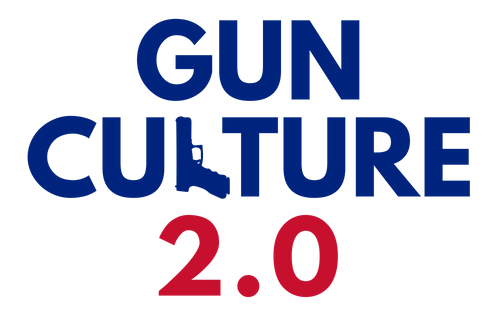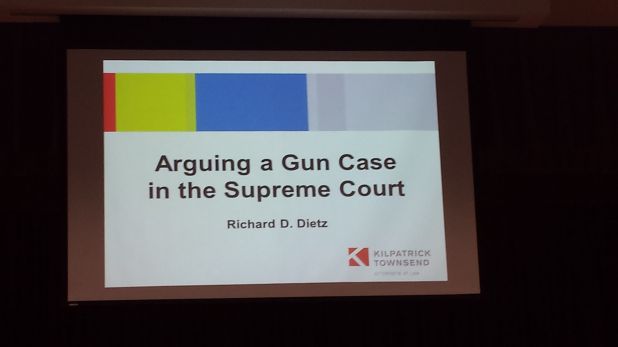It is not often that one has the opportunity to hear a talk by someone who has argued before the Supreme Court of the United States. Through the email newsletter of a local gun store and range, Pro Shots, I was fortunate to learn of such an opportunity here in my home town on May 1st. Richard Dietz, a local attorney, spoke at the monthly meeting of the Forsyth County Republican Party about his experience arguing on behalf of the petitioner in Abramski v. United States (No. 12-1493) in January 2014.

Dietz is a graduate of the Wake Forest University School of Law (2002) and an attorney with Kilpatrick Townsend in Winston-Salem, North Carolina. He specializes in appellate and constitutional law.
Abramski v. United States was the first major gun-related case considered by the Supreme Court since McDonald v. Chicago in 2010. The case concerns Bruce Abramski, a former police officer, who bought a handgun in Virginia for his uncle who lived in Pennsylvania. Abramski completed the Bureau of Alcohol, Tobacco, Firearms, and Explosives (ATF) Form 4473 (“Firearms Transaction Record”) and passed a National Instant Criminal Background System (NICS) check. He then personally took the gun to Pennsylvania and transferred it to his uncle through a business with a Federal Firearms License (FFL). His uncle completed Form 4473 and passed a NICS check before taking possession of the gun.
Subsequently, through a bizarre series of unrelated events, Abramski was arrested and charged with two felonies on the grounds that he had made a “straw purchase” on behalf of his uncle and had lied on Form 4473 when he checked the box that said he was the “actual transferee/buyer” of the gun.
The legal details of this case are complex, but in the talk I attended Dietz offered some interesting perspectives on the case. He particularly stressed the need to understand the politics of gun regulation and the actual substance of legislation on guns in order to render a legal judgment in this case.
Dietz argued that the Gun Control Act of 1968 represented a political compromise between those seeking more gun regulation and those opposed to it. The compromise struck was that licensed firearms dealers would be heavily regulated, but that the activities of private citizens (buying, selling, trading, gifting) would be largely unregulated.
He argued that from 1968 until the 1990s, the idea of a “straw purchaser” applied only to someone who was purchasing a gun on behalf of a prohibited person (which itself was defined in the 1968 Gun Control Act, although the specific phrase is never used there). There was nothing in the law to prohibit a private citizen from buying a firearm for someone who was legally allowed to possess it (whether to re-sell or to gift). Dietz showed an ATF memo from the early 1980s which documented the ATF’s agreement with this position at that time.
Subsequent to the passage of the Brady Handgun Violence Protection Act of 1993, the Clinton Administration sought to expand the idea of the straw purchaser to include anyone who bought a firearm on behalf of another person, even if the person could legally own a firearm. One reason for this was to create a system in which more people who ended up with firearms would have to go through criminal background checks – a central idea of the Brady Law.
This expansion was realized when the ATF modified (in 1995) Form 4473 to include a question specifically designed to identify “straw purchasers.” In its current form, Question 11a asks:
“Are you the actual transferee/buyer of the firearm(s) listed on this form? Warning: You are not the actual buyer if you are acquiring the firearm(s) on behalf of another person. If you are not the actual buyer, the dealer cannot transfer the firearm(s) to you” (emphasis in original).
The additional instructions for question 11a given at the back of the form are:
“Question 11.a. Actual Transferee/Buyer: For purposes of this form, you are the actual transferee/buyer if you are purchasing the firearm for yourself or otherwise acquiring the firearm for yourself (e.g., redeeming the firearm from pawn/retrieving it from consignment, firearm raffle winner). You are also the actual transferee/buyer if you are legitimately purchasing the firearm as a gift for a third party. ACTUAL TRANSFEREE/BUYER EXAMPLES: Mr. Smith asks Mr. Jones to purchase a firearm for Mr. Smith. Mr. Smith gives Mr. Jones the money for the firearm. Mr. Jones is NOT THE ACTUAL TRANSFEREE/ BUYER of the firearm and must answer ‘NO’ to question 11.a. The licensee may not transfer the firearm to Mr. Jones. However, if Mr. Brown goes to buy a firearm with his own money to give to Mr. Black as a present, Mr. Brown is the actual transferee/buyer of the firearm and should answer ‘YES’ to question 11.a. However, you may not transfer a firearm to any person you know or have reasonable cause to believe is prohibited under 18 U.S.C. § 922(g), (n), or (x)” (emphasis in original).
The language on the form seems pretty straightforward, so the heart of Abramski’s appeal is that there are no prohibitions in the Gun Control Act of 1968 on the private sale of firearms to another lawful purchaser. In effect, the ATF has no legal right to ask question 11a about the “actual transferee/buyer” of a firearm. The current ATF understanding of straw purchasers is not grounded in the law as it was hammered out in the political compromise that led to the Gun Control Act of 1968.
The specific legal questions being addressed in Abramski are, of course, more complex than that. But I got from Dietz’s talk that this is the heart of the matter on which the Supreme Court will be rendering a decision by June.


[…] my Gun Culture 2.0 blog recently I wrote about attending a talk by an attorney who had argued recently before the Supreme Court of […]
LikeLike
Great article. Thanks for the info, it’s easy to understand. BTW, if anyone needs to fill out an atf form 4473, I found a blank form here http://goo.gl/6yTrH2
LikeLike